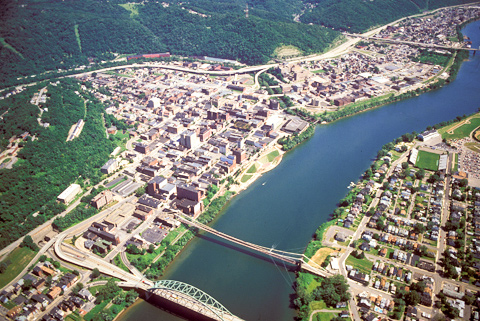Foggy this morning according to custom,” Lewis complained on 7 September 1803. “Set out at half past seven, and in about two hundred paces stuck on a riffle all hands obliged to get out. . . . got over the riffle at 45 mts. after 8.” Before long they passed a “handsome little Village, containing about forty houses.” That was “Charles town,” chartered in 1791, and renamed Wellsburg in 1816. That was where Patrick Gass, who enlisted in the Corps of Discovery at Camp Dubois, spent his last years, and died on 2 April 1870, at the age of 99.
Sixteen miles farther on, at 5 in the afternoon, they arrived at Wheeling (at left in the photo)—which was then in the state of Virginia—”a pretty considerable Village [that] contains about fifty houses.” It was “remarkable for being the point of embarkation for merchants and Emegrants who are about to descend the river, particularly if they are late in getting on and the water gets low as it most commonly is from the beginning of July to the last of September; the water from hence being much deeper and the navigation better than it is from Pittsburgh or any point above it.”
The barge (called the ‘boat’ or ‘barge’ but never the ‘keelboat’) had a capacity of fifteen tons of cargo, but Lewis had contracted with a wagoner to haul a substantial part of his baggage from Pittsburgh to Wheeling. In 1803 most overland travel routes were narrow paths best suited to foot and horse traffic. There were only a few thousand miles of decent, if mostly unpaved, wagon roads in the seventeen states, and Wheeling was the western terminus of one of the newest of them.
Although French explorers had been on this part of the Ohio in 1749, and George Washington had surveyed the land hereabouts in 1770, the town was officially established in 1795, and incorporated in 1806. The name, which is said to have come from an Indian word meaning “place of the skull,” was borrowed from Wheeling Creek, at the mouth of which an early white settler was scalped and decapitated. The creek still curves through the town today, entering the Ohio near the business district.
Talking Politics
The next day Thomas Rodney, a Revolutionary War veteran whom Jefferson had appointed to adjudicate land claims in Mississippi Territory, “Visited Captain Lewess barge.”[1]Dwight L. Smith and Ray Swick, A Journey Through the West: Thomas Rodney’s 1803 Journal from Delaware to the Mississippi Territory (Athens: Ohio University Press, 1997), 50-52. Lewis demonstrated his air gun, which Rodney admired as “a curious peice of workmanship not easily discribed.”
Later that day he returned to “Captain Lewes’s barge to eat watter millons.” They talked the next morning also, according to Judge Rodney. Even though both France and the United States had already signed off on the Louisiana Purchase, the territory was still under Spanish control, so Lewis delivered the “official” interim story he and Jefferson had agreed upon:
Captain Lewes’s object is to assend the Misisipi and to visit the Lake of the Woods, to assertain accurately its lattitude and longitude and as well as the head of the Misisipi, and then to return to or cross over to the Misouri and explore those parts and branches of it that are yet unknown and the country of Louisiana west of the Misisipi.
Lewis nevertheless strongly hinted that there was more he could not discuss. He merely emphasized that British commercial enterprises in upper Louisiana “may in future be the cause of dispute and trouble between the United States and G. Brittain unless early prohibited.”
The judge was somewhat doubtful of the expedition’s success. “Captain Lewes is a stout young man but not so robust as to look able to fully accomplish the object of his mission, nor does he seem to set out in the manner that promises a fulfilment of it.” For one thing, the barge was too heavy, and its draft too deep, to make it up the Mississippi “and other rivers.” Lewis had told him about the makings of a portable iron-framed boat he had brought, but Rodney thought Lewis should have “adopted the long experience of the Canadians and used the bark canoes that are used by them in their northern trade.” Clearly, Rodney didn’t know there would be no birch trees along the Missouri suitable for such a purpose. But how did Lewis know that? No one knows for sure, but the irrepressible jawbone journals, like the moccasin telegraph, spread news of all sorts faster than printing presses.
From Discovering Lewis & Clark from the Air
Photography by Jim Wark
Text by Joseph Mussulman
Reproduced by permission of Mountain Press
Notes
| ↑1 | Dwight L. Smith and Ray Swick, A Journey Through the West: Thomas Rodney’s 1803 Journal from Delaware to the Mississippi Territory (Athens: Ohio University Press, 1997), 50-52. |
|---|
Experience the Lewis and Clark Trail
The Lewis and Clark Trail Experience—our sister site at lewisandclark.travel—connects the world to people and places on the Lewis and Clark Trail.
Discover More
- The Lewis and Clark Expedition: Day by Day by Gary E. Moulton (University of Nebraska Press, 2018). The story in prose, 14 May 1804–23 September 1806.
- The Lewis and Clark Journals: An American Epic of Discovery (abridged) by Gary E. Moulton (University of Nebraska Press, 2003). Selected journal excerpts, 14 May 1804–23 September 1806.
- The Lewis and Clark Journals. by Gary E. Moulton (University of Nebraska Press, 1983–2001). The complete story in 13 volumes.


